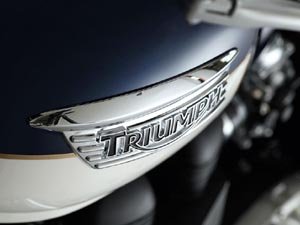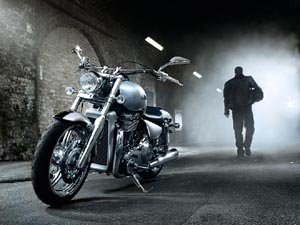Triumph, an old name with modern appeal
In the world of motorcycling Triumph is one of those names that reads like aristocracy. Like its car-manufacturing counterpart, the marque was very much at the forefront of the evolving history of motoring, building itself a legendary heritage in the process. The renaissance of this great old name is therefore every bit as important as the revival of the Bugatti brand was – all the more so because today Triumph once again makes some of the most beautiful bikes around.
 Some give us the advice never to look back, saying that in the world of business – motor vehicles included – there is no place for tradition or sentimentality. I disagree. Cars and bikes are not just functional machines that perform a function. They never have been and hopefully never will be. Instead, they form a surprisingly important part of our society, becoming the stuff of childhood dreams, the driver of many aspirational ambitions, the way by which we are measured in terms of success and above all an expression of our sense of style and personality.
Some give us the advice never to look back, saying that in the world of business – motor vehicles included – there is no place for tradition or sentimentality. I disagree. Cars and bikes are not just functional machines that perform a function. They never have been and hopefully never will be. Instead, they form a surprisingly important part of our society, becoming the stuff of childhood dreams, the driver of many aspirational ambitions, the way by which we are measured in terms of success and above all an expression of our sense of style and personality.
While we should be above the simple ranking of people by the car they drive or the bike they ride it can also say a lot of interesting things about them. Bikers, above all, are known as free-spirited people with just a hint of rebellion in their bellies. Those who put on the leathers and fasten the straps of their helmet therefore issue an unwritten declaration to the world of their desire to experience exhilaration and freedom – if nowhere else at least on the road.
The power of tradition
If you look at it in a perfectly rational way perhaps we should see our modes of transport as just that; utilitarian machines that take us from one point to the next. However, this is not how the human psyche works. We tend to enthuse and become involved, and those with a particular love for the road almost inevitably develop a love affair with the two-wheeled machine that offers an even purer, more authentic driving experience than any car could.
In spite of all the technology on modern motorbikes it is still all about you, the road and the elements. In this environment, where emotion and symbolism play such strong roles, such factors as tradition and nostalgia carry almost as much weight as technology, design and performance.
The rebirth of Triumph
 When John Bloor took over the rights to the Triumph brand in 1984 he sought to make a clean break with over a decade of mismanagement, industrial strife and falling standards that eventually resulted in the collapse of the original company in 1983. This was a period that had stood in stark contrast with the many decades during which Triumph had earned itself a legendary reputation as the maker of sumptuously designed and engineered machines. A plethora of technical firsts meant Triumph stood at the vanguard of both quality and innovation, with the lovely Bonneville as the icon of an era when the likes of Marlon Brando, Steve McQueen and James Dean were all seen on one – both on and off the silver screen.
When John Bloor took over the rights to the Triumph brand in 1984 he sought to make a clean break with over a decade of mismanagement, industrial strife and falling standards that eventually resulted in the collapse of the original company in 1983. This was a period that had stood in stark contrast with the many decades during which Triumph had earned itself a legendary reputation as the maker of sumptuously designed and engineered machines. A plethora of technical firsts meant Triumph stood at the vanguard of both quality and innovation, with the lovely Bonneville as the icon of an era when the likes of Marlon Brando, Steve McQueen and James Dean were all seen on one – both on and off the silver screen.
The Bonneville epitomised what Triumph stood for and has become an enduring classic, as well as the inspiration of the new Triumph company in reviving the grandeur of old. The news of Triumph’s revival caused a great stir among enthusiasts, and harnessing the power of nostalgia and tradition Triumph has created a new niche for itself among stiff competition from Japanese, Italian and American makes. None of this would have worked, however, had the company not succeeded in producing a new line of models entirely worthy of the famous name they carry.
Modern classics
The modern Triumph engineers have built on the tradition and values of the classic Triumph era, and in so doing have created models that perpetuate the legend in the here and now. Starting with the early Triumph Trophy, the Daytona and the Trident, the company rebuilt its market in Europe and the US, developing a range that now includes such unabashed retro models as the Bonneville and the raucous Thruxton, but also imposing roadsters such as the Speedmaster, the Thunderbird and the Rocket III, the world’s largest production bike.
Their sumptuous styling and classic detailing stands in contrast with the ultramodern Speed Triple Tiger series and other urban sports bikes designed to take the fight directly to the likes of Suzuki, Honda and company. Precision workmanship and fine engineering are standard in all these models, regardless of their styling and tuning, as is state-of-the-art technology, showing that Triumph has fully evolved into its new era – and that a classic brand, nostalgic undertones and modern technology can come together in great harmony.












